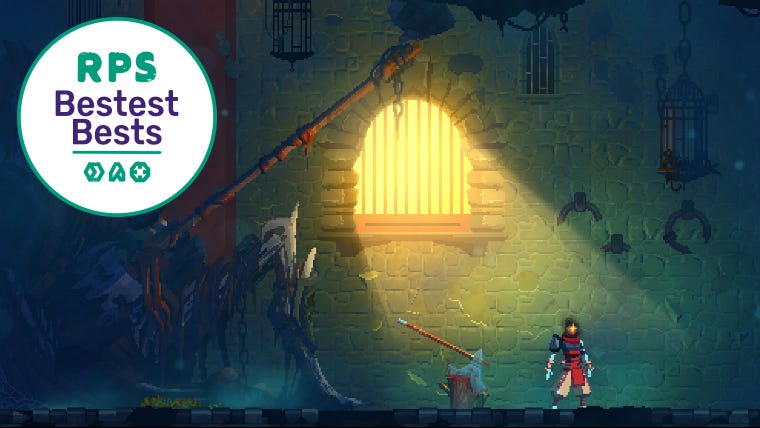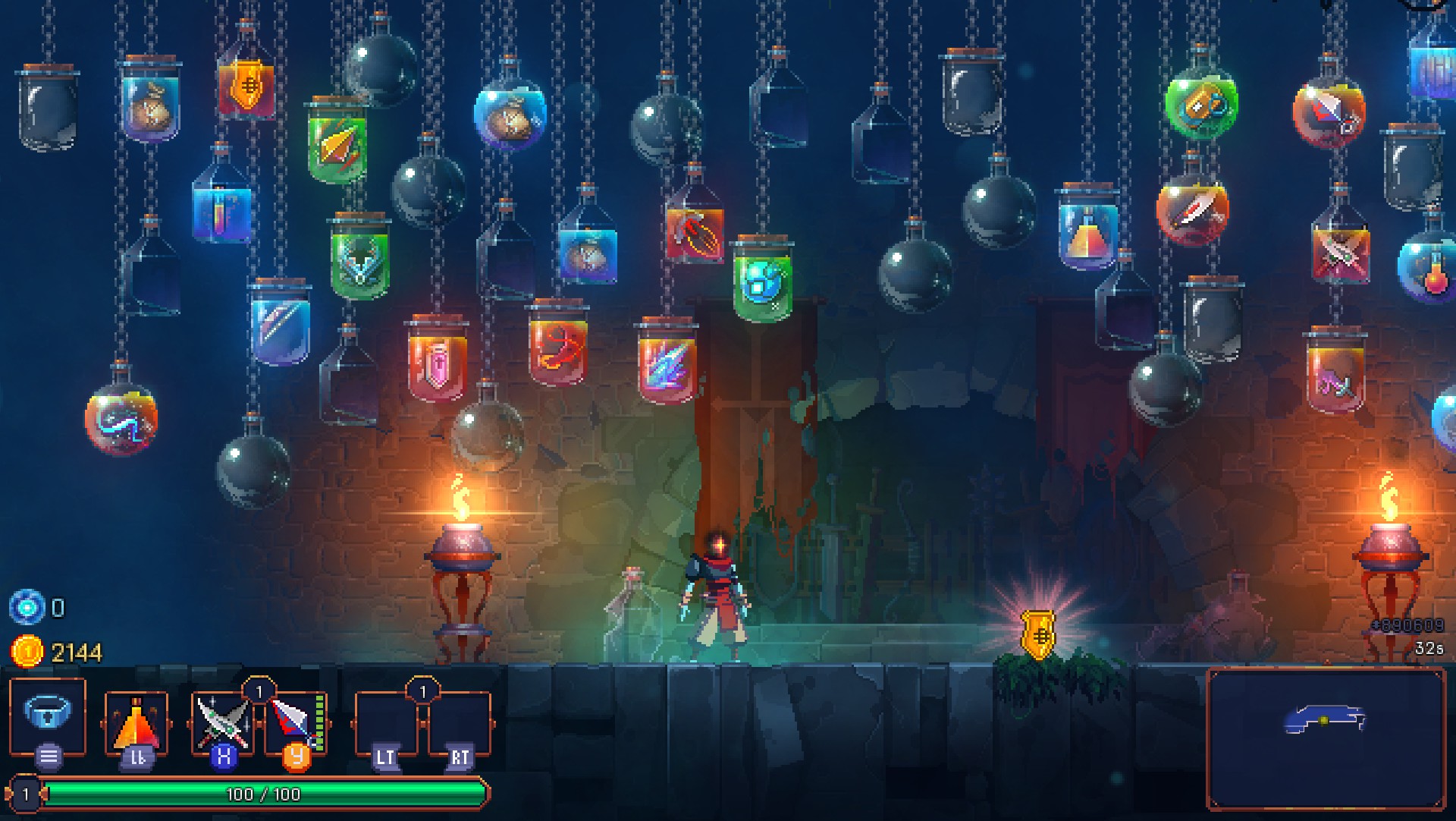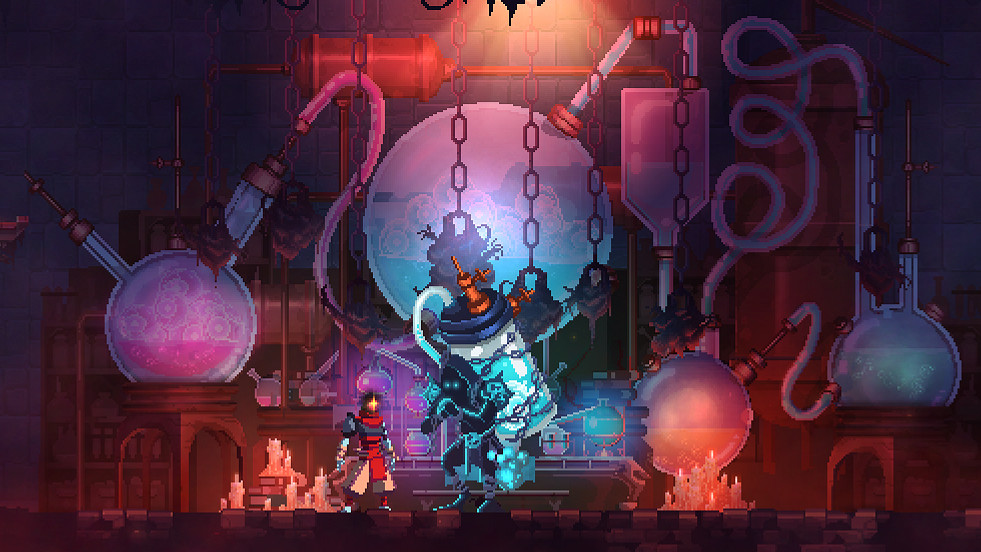Wot I Think: Dead Cells
What a handsome rogue
Dead Cells gets into your nervous system like a wonderful toxin. If it wasn’t so fast-paced, you could almost feel the electro-chemical effects pulsing through your body, from hand to eye to screen to brain, as your panicked flurry of knife strikes eviscerates another sewer worm. The game began as a “roguevania”, and it was strong even in its early days. But the final version has seen every edge of this Castlevania homage sharpened to the point of needing a big cork on top. The verbs “hack” and “slash” have rarely been put to better use.
For those who still haven’t woken up in a dungeon without a head, you play as an undead body taken over by a glob of slime. Don’t worry about the how and why, you’ll be too busy with the stab and roll. You’ve got to make your way up clock towers, through sewers and across castle walls, killing enemies for gold. Occasionally they’ll drop blueprints to new weapons. Between levels you cash in those goodies thanks to a big hooded man. If you die you go right back to the start, sliming your way back into that corpse. During your next "run" all the levels will have different layouts. Familiar, but rearranged.
But between those levels you also bank cells (big blue discs dropped by the horrible lampreys and zombie pirates). Banking cells lets you use more weapons and abilities. Maybe you’ll unlock that crossbow that shoots loads of bolts at once, or an ice grenade that freezes your foes, or the ability to warp behind the nearest enemy for a nasty backstab. It's a game of fighty toys, every new gizmo randomly opening up a slightly different way to disembowel your enemies. In an attempt to lure completionists to certain doom, there’s a whole chamber where every piece of kit you’ve unlocked hangs in a jar above your head. Tell yourself it isn’t working.
The real success is that it feels good. Every roll, double-jump and sword slash feels Goldilocks-zone perfect, its timing honed to the millisecond. The words of this review would be rendered obsolete if I could only put an Xbox controller in your hand and say: “Have a stab at thon zombie, friend.” It’s a rush-down of reflexes and control, but you don’t have time to get comfortable, since new bows or shields will make you re-program your instinctive slashes or archery volleys in the middle of whatever horrible fishing village you’re stumbling through.
In fact, the longer your run goes on, the more hazardous and chaotic your build becomes. Skills like buzzsaws or stun grenades complement your rapiers and axes. You're also boosted by mutations. These are passive bonuses that, say, give you HP for every kill, or make you stronger when close to your turrets. If you’re lucky, your death-devices will work together in bloodlusting harmony. An infantry grenade might cause baddies near a victim to freeze, and then your warhammer might do 100% extra damage to frozen enemies.
Whereas earlier levels see you getting used to your handful of toys, later levels see you entrusted with golden murder gadgets, each boasting more effects and bonuses than you can sometimes keep straight. As you discard and build your tiny arsenal, all the percentages and bonuses and conditions come screeching out in the form of rapidly bleeding or exploding corpses, toxic clouds full of exclamation points to dodge, cheeky turrets chipping away at spikey turtle men.
This last skill – the crossbow turret, flamethrower and assorted variety of stationary gun - are my favourites. But you have to be nearby for them to operate. There’s still an element of cheesing some baddies, by throwing down a blade-dispensing "sinew slicer" and standing aside. But the game almost seems to know what you’re doing, and it won’t let you get away with such a hands-off approach for long. Later enemies teleport straight to you. Others grab you with a hook from afar. Gangs of cannonball-firing clockwork henchmen can keep you from standing still by plastering the screen with clusterbombs. This game hates to see you standing still.
There is plenty of carrot along with those warpy sticks though. Some doorways can only be opened if you reach them in time, containing blueprints, upgrade scrolls, gold and stacks of cells. You also get a speed bonus for killing and killing and killing, never losing pace or stopping to think.
This focus on speed might be overwhelming for some folks. There are reprieves between areas, and the occasional bit of lore (a statue of a king to inspect, a door to batter, a creepy bell tower laboratory to investigate) but they don't last long. I prefer it that way, because it isn’t intrusive, more like brief snippets of dialogue or thoughts, meant to reveal a kingdom’s downfall. It’s lore lite, and for that I’m thankful, because there is hacking and slashing to be done. But the bakeries and hidden chambers staffed by bread hawkers and shop keepers might not be enough for those seeking more peaceful or quiet moments, or a game that allows you to strategise and consider your options.
There is some thoughtfulness, thanks to the odd builds you can stumble upon (a tactics-based turret-toting tail-turner, for example). But mostly, combat is a matter of coming up with a plan on the hoof, especially during a boss fight, when all your habits are suddenly punished by giant searching tentacles or a hook-shotting clock lady. Here, you’ll find yourself changing your priorities mid-fight, and cursing your hands for executing that sword strike before your chubby digits had time to register the brain telling them to roll, for the love of god, ROLL.
That love of versatility shows in the game design too. We knew this was a genre mash-up the moment it pronounced itself a “roguevania” but it’s pleasing to see just how many elements have been borrowed and put to good use. And I don't just mean the whip-cracking of Castlevania or map-revealing of Metroid. There is much more to spy here. For instance, your health bar regains some lost health if you strike back an enemy who has wronged you. That’s a Bloodborne trick, forcing you into fast-paced, do-or-dare scrapping. Use an electric whip on water and the electricity will spread throughout. BioShock and others will nod approvingly (you can also freeze the pool with an icy blast and enemies will be locked in place by their ankles). And the level-building magic is based on the hybrid approach of Spelunky, mixing procedural generation with “handmade” rooms. What’s impressive isn’t that developers Motion Twin have Frankensteined themselves a monster out of bits and pieces of other games, but that they've made a monster where the stitches never show. Every organ and limb feels like it belongs, and functions as it ought to. It's an expertly crafted videogame.
There is an element of grind to it, though, hidden beneath the tight controls. New weapons or skills can only be used once you find a blueprint. But you have to get to the end of the level to cash that blueprint in. And even then you have to pay a sum to the collector to unlock it. Once unlocked, it’ll pop up randomly in future runs, usually lined up among a shopkeeper’s wares. I’m not joking when I say it tempts completionists towards a profound pitfall. Having sunk dozens of hours into the poisonous hallways and cloudy catacombs, I still haven’t collected more than half of this stuff. That holding back of the gadgets can be lessened with a pokéball-like grenade that helps you collect blueprints. But I've found that the longer you play, the rarer your discoveries.
It is also a deceptively time-consuming game, though in the best possible way. This is a two-dimensional daggerworld that invites you to play for 10 or 20 minutes bursts, but then you end up playing for an hour, two hours, three hours. Either can be done, but it takes a will stronger than mine to end a run early, and just as strong a will to walk away from “one more run”. In that way, Dead Cells infects you with its own sense of momentum, demanding that you keep pace, until you throw a bear trap when you should have jumped, and you die to the tele-zapping maggots you thought you’d dealt with. How embarrassing.
In short, every little fracas is a trial of quickness, luck and body memory, and it feels superb. I could talk more about the daily challenge mode, or the new "malaise" that infects you when certain enemies strike, or whether or not the game counts as a “true metroidvania” (this is an argument that boils the collective piss of team RPS and will never be resolved). But I’m happier to just recommend it on the strength of its movement alone. Blisteringly fast when it needs to be, challenging without being frustrating, and packed with sharp, fatal toys, Dead Cells doesn’t keep you on your toes, it keeps you on your toenails.
Dead Cell is out on August 7th on PC, Mac and Linux via Steam and GOG for £21.99/24.99€/$24.99


















